“The Dream of John Manjiro” or John Manjirō no Yume (ジョン万次郎の夢) is the title of a Japanese musical being staged in Japan nationwide from March 2023 to March 2024 by the renown Shiki Theatre Company (劇団四季).
Anybody interested in Japan-US relations would be interested in John Manjiro, a famous 19th-century anomaly in Japanese diplomatic history. Originally a 14-year-old, peasant fisherman from rural Tosa Province (Kochi Prefecture), he went fishing with a few friends on a boat for the first time in 1841 only to get shipwrecked on a remote island (Torishima) way south of Tokyo. It was the start of his most unexpected and historic adventure.
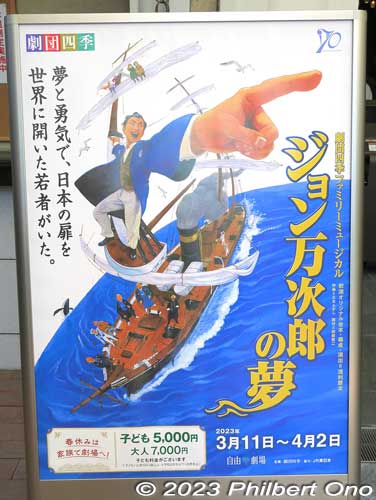
They got rescued by an American whaling ship which took Manjiro to America where he studied and became a whaler and even joined the California Gold Rush. He returned to Japan in 1851 while Japan was still in self-imposed isolation from the world.
Back in Japan, he became a high-ranking samurai and government advisor and translator for treaty negotiations with Commodore Perry of the United States in 1853–54. He wanted to help open up Japan and bridge Japan and the US. To this end, he also became a college professor in his latter years.
His incredible life is depicted in this colorful and entertaining two-hour family musical filled with song and dance. The entire cast is Japanese, and they all speak and sing in Japanese except for a few lines in English. Special eyeglasses projecting English subtitles is not available for this show. Since there’s almost nothing in English, I’m writing this English review of “The Dream of John Manjiro” musical.
“The Dream of John Manjiro” was originally scheduled for a nationwide tour in 2020, but the pandemic postponed the performances to March 2023. It’s been nine years since the last time they put on this show in 2014.
I went to see it in Tokyo where it played from March 11 to April 2, 2023 at the 500-seat Shiki Theatre JIYU near Hamamatsucho Station. Admission was ¥7,000 with all reserved seating. It will return to the Tokyo area on April 29 (Sagamihara), July 2 (Shinjuku), and Dec. 26, 2023 (Tokorozawa) while touring from Hokkaido to Okinawa.
Tickets go on sale a few months before the performance. The shows often sell out, so they might not have any tickets left at the door. Check here for ticket availability at the door. Complete schedule here. In Japanese here. You can buy tickets online here.
“The Dream of John Manjiro” was first staged in 1974. It was created by the late Asari Keita (浅利慶太) who founded Shiki Theatre Company in 1953.
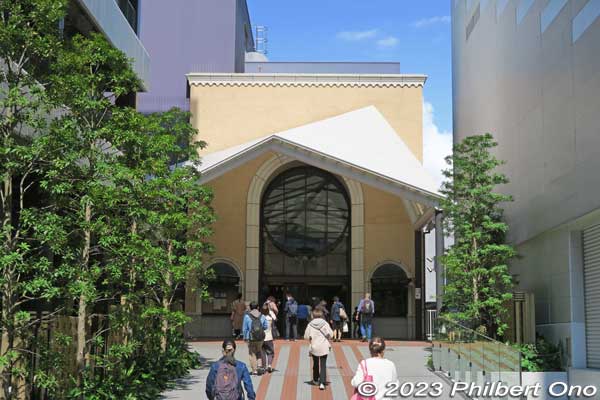

CONTENTS
- Main characters
- Plot: Shipwrecked | Rescue | Fairhaven | Return to Japan
- Performance Schedule
- About Shiki Theatre Company
- Further reading
Main characters
I counted a total of 28 characters in the musical and all the actors and actresses look to be native Japanese. American characters are dressed in Western costumes. All the characters are played by two alternating actors/actresses. So each performance has a signboard indicating who is in the cast.
A few actors play two different characters. Most cast members are supporting actors or background dancers and singers (eight members each in the male and female ensemble). Most of the cast look to be in their 20s or 30s.
With lots of dancing and singing, the roles are physically demanding, and the result is a crowd pleaser. Shiki Theatre Company is known for its high standards in their performers, and a very small percentage of applicants pass the audition to get in the Company and be cast. So what you see are elite performers.
Here are the main characters:
- John Manjiro aka John Mung or Nakahama Manjiro (中浜 万次郎): Main character who was from a fishing village in Kochi Prefecture and got the adventure of his life in America and Japan after getting shipwrecked on Torishima island south of Tokyo.
- Denzo, Jusuke, Toraemon, and Goemon (伝蔵親方, 重助, 寅右衛門, 五右衛門): Four fishing friends who got shipwrecked with Manjiro and were rescued and dropped off in Honolulu. Denzo (originally named Fudenojo 筆之丞), Jusuke, and Goemon were brothers. Denzo was the eldest brother and captain of the shipwrecked fishing boat.
- Captain William Whitfield: Captain of the passing John Howland whaling ship that rescued Manjiro and his friends stranded on Torishima. He takes Manjiro to Massachusetts where he and his wife adopts him like a son and sends him to school.
- Mrs. Whitfield: Captain Whitfield’s wife in Fairhaven who also lovingly welcomes Manjiro.
- Shimazu Nariakira (島津 斉彬): Daimyo feudal lord of Satsuma who ruled Kagoshima and Okinawa. He favored Western technologies and culture and was in favor of opening Japan. He was supportive of Manjiro back in Japan.
- Katsu Kaishu (勝 海舟): Samurai retainer and commander of the Kanrin Maru Japanese warship that sailed across the Pacific Ocean in 1860 to take the Japanese Embassy’s entourage to the U.S. He was a reformist in favor of opening Japan.
- Fukuzawa Yukichi (福沢 諭吉): Intellectual and member of the Japanese Embassy entourage on the Kanrin Maru to the U.S. He studied and taught English and later founded Keio University.
- Kin and Gin: Two fictional newspaper reporters from the Edo Period explaining the play’s historical background.
- Ally and Polly: Two fictional newspaper reporters from America explaining the play’s historical background together with Kin and Gin.
Plot
In case you don’t understand Japanese, this is the musical’s basic plot. The musical does not depict everything in Manjiro’s life, so I also fill in the gaps missing in the musical. Such supplemental information are in italics.
Spoiler alert: If you don’t want to know how the show progresses or ends, best to skip reading this section and jump to the Performance Schedule below.
Opening
The musical opens with a large, old map of Pacific Rim countries projected on a large screen. Japan is on the left and the mainland USA on the right. In the middle of the Pacific Ocean, Oahu (Hawaii) is labeled as “Uhafu” (ウハフ).
Two fictional female newspaper reporters, Kin and Gin, from the Edo Period and two female news reporters Ally and Polly from America appear on stage in period costumes and briefly explain the historical background. That Japan was in self-imposed isolation and the Japanese have not yet seen foreigners, thought of as evil ogres. Coming into contact with foreigners was prohibited except at Nagasaki.
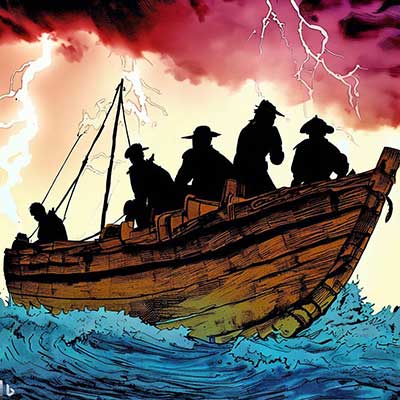
Gone fishing
The next scene shows Manjiro in his hometown of Nakanohama, Tosa Province (present-day Tosashimizu, Kochi Prefecture). He tells his mother he will go fishing on a boat for the first time with four friends: Goemon, Denzo, Toraemon, and Jusuke. They depart from Usa (pronounced oo-sah) in present-day Tosa city on January 5, 1841 to fish off Cape Ashizuru for mackerel. At age 14, Manjiro is the youngest on the boat.
While on a moving boat prop on stage, Manjiro and his friends chat about what was beyond the horizon. That there were fearful, red ogres called nanban (南蛮), a term used at the time to refer to foreigners (barbarians). They all sing on the boat.
They soon encounter a severe storm and rough waves. To simulate rough waves, stage hands wave large white sheets beside the boat on stage. They drift for eight days until they joyfully see a small, uninhabited island (Torishima) and paddle toward it. Their boat gets wrecked by waves and they manage to swim ashore. They are then shown lying on the beach, dazed and hungry. Jusuke had injured his leg.
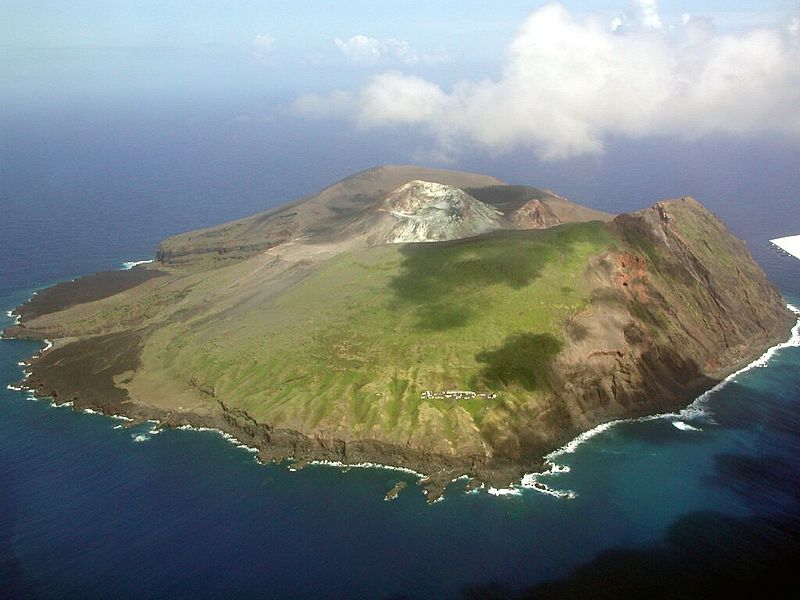
Shipwrecked on Torishima
They are stranded on the island for about five months, surviving on birds (albatross) and seaweed, all eaten raw. It was easy to catch the slow-moving albatross. But when the birds started to migrate away from the island in spring, food got scarce. They had no fire and little freshwater. No natural springs and little rain. The musical does not show them killing or eating any birds or seaweed.
One day, an excited Manjiro runs to his friends to report that he saw a large ship. It was nothing like he had ever seen before, so it must be foreign. They noticed Manjiro’s call for help and signaled that they would come ashore.
It turned out to be the American whaling ship John Howland whose captain William Whitfield was from Fairhaven, Massachusetts. They were coming to the island on two small boats to look for turtle eggs and freshwater. It was June 27, 1841.
Today, Torishima is uninhabited and a protected bird sanctuary and natural monument. “Torishima” (鳥島) means “Bird Island.” People need special permission to land on the island. Located about halfway between mainland Tokyo and the Ogasawara islands, Torishima is part of Tokyo.
Rescued by American whaling ship
On stage, Whitfield comes ashore with two crew members. He first speaks in English introducing himself (“My name is Captain Whitfield”) and asking Manjiro for their names. “What is your name?” Manjiro and his panicked and frightened friends could not understand anything and imagined in Japanese what Whitfield said. A humorous exchange. This is the rare scene when we hear English dialog in the musical as spoken by Whitfield. Whitfield actually did not land on the island, only his men did.
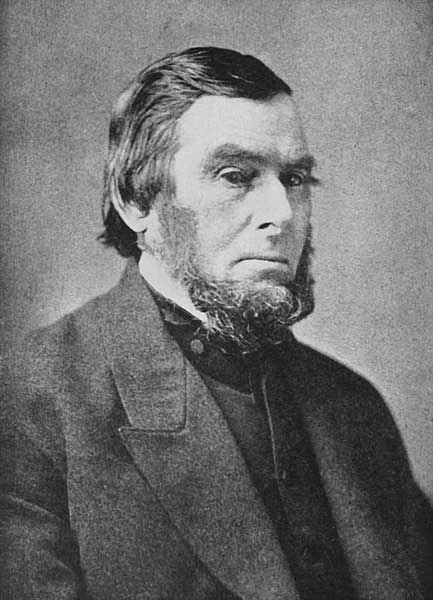

Manjiro and friends at first argue over whether they should go with Whitfield and to the unknown. Having a good survival instinct and common sense, Manjiro convinces everyone that they should be rescued to escape their chronic hunger and thirst. Through gestures, etc., Whitfield managed to find out that they were Japanese. However, he could not take them back to Japan which was closed to foreign ships.
Manjiro and friends were surprised that the Americans harvested mainly the whale oil and discarded the meat. After whaling for several months in the north Pacific, the ship stopped in Honolulu in Nov. 1841 to drop off Manjiro’s friends. The musical does not show the ship stopping in Honolulu.
Hawaii was a major hot spot in the whaling industry where hundreds of whaling ships would stopover every year from the 1820s to 1860s to replenish provisions. It boosted Hawaii’s agriculture for vegetables, potatoes, fruits, and sugar and ranching for beef that the whalers wanted. Honolulu, Lahaina (Maui), and Hilo (Hawaii island) were teeming with whaling ships.
Japanese waters were also a major whaling ground, so most all ships stopped by Hawaii on the way to the Japanese coast. A significant number of whaling crew were from Hawaii, and a good number of them even settled in New Bedford, Massachusetts. The whaling industry drove Hawaii’s economy for 40 years. Even today, there are remnants and museum artifacts of Hawaii’s whaling history.
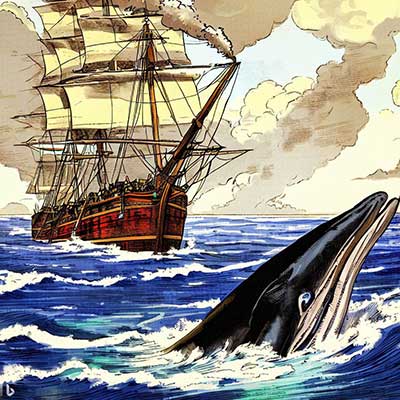
Seeing promise in Manjiro who was at the right age to be trained, Whitfield wanted to take Manjiro with him to America. After some debate, Manjiro eagerly accepts Whitfield’s offer and stays onboard and learned about whaling.
From Honolulu, they sailed through the South Pacific to the Gilbert islands, Guam, passed by Japan, Torishima, and Honolulu again, and sailed to Tahiti, Fiji, Guam (again), before sailing around South America to the U.S. East Coast. They were at sea for 16 months. Most whaling ships had a crew of 20 to 30 men.
It was during the whaling industry’s peak period when whale oil was used as fuel for lighting and machinery oil before petroleum products started taking over from the 1860s.
While on the ship, Whitfield gives Manjiro the name “John Mung.” “John” was apparently taken from the ship’s name and “Mung” was an abbreviation of “Manjiro.” Manjiro is happy to receive an English name.
Although today he is popularly called “John Manjiro,” he never used that name. After returning to Japan, he adopted the Japanese name, “Nakahama Manjiro.” The “John Manjiro” nickname first appeared in the title of a novel by award-winning author Masuji Ibuse in 1937 and it has stuck.
Manjiro also learns the phrase, “Thar she blows!” for whenever a whale was spotted. He got quite good at spotting whales high atop the main mast. The props include a large sailing mast in the background.
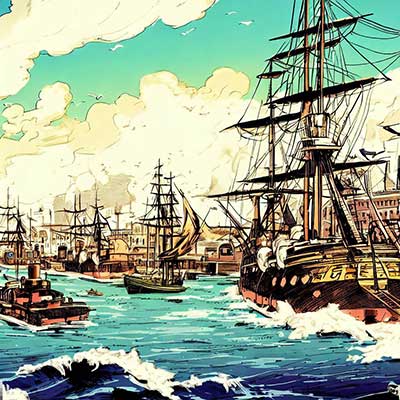
Arrival in Fairhaven
After 16 months at sea, Manjiro (age 16) and Whitfield in May 1843 finally dock at New Bedford, a major whaling port in Massachusetts. They go to neighboring Fairhaven, Whitfield’s hometown, where Manjiro is adopted a like son by the Whitfields.
There’s a nice dance sequence on stage welcoming Whitfield and Manjiro to Fairhaven with stage props showing harbor scenery and whaling ships. (Seen in the trailer video above.)
Manjiro lives in Fairhaven and attends school to study English, math, marine navigation, surveying, and ship building for three years. He becomes Japan’s first person to study abroad and was an outstanding student. He learns the ABC song and the musical performs it.
Manjiro is welcomed by the locals for the most part except by the local church patronized by the Whitfields. The church, represented by two women visiting the Whitfields, said they would have to sit in the segregated part of the church.
During this meeting, Manjiro is seen in the stage corner looking down, feeling bad about causing such trouble. But the Whitfields tell him it was okay and they decide to join another church instead.
The next scene shows Fairhaven people discussing the futility of Japan’s self-imposed isolation and the frustration of whaling ships being banned from Japanese ports. Whitfield states that Japan should open up, but more importantly, the Japanese people must open up their hearts to the world.
This affects Manjiro who develops a strong desire to help open Japan’s ports and act as a bridge between Japan and America. It was his dream which he even told Whitfield. After whaling at sea, he knew very well how important it was for whalers to have access to Japanese ports and resupply their ships.
The first half of the musical ends with Manjiro declaring his desire to return to Japan despite the risks of punishment (even death) for coming into contact with foreigners.
Intermission (15 minutes)
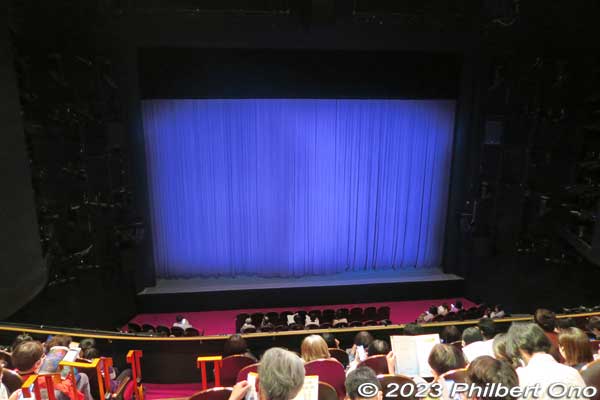
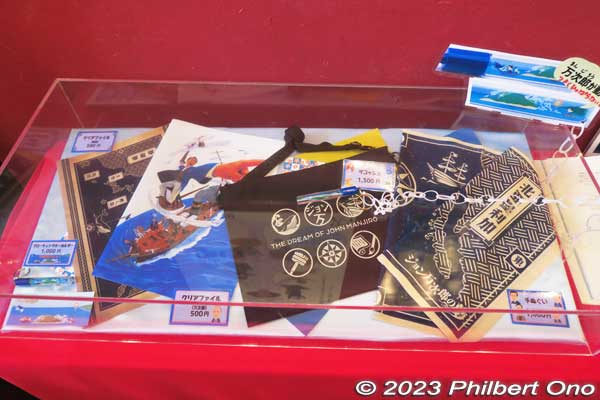
Although not shown in the musical, Manjiro learned to be a cooper to make whale oil barrels and finished his studies in 1846 at age 19. He then worked on the whaling ship Franklin as a steward from May 16, 1846 and sailed around the world for 30 months. From New Bedford, his ship sailed around Africa to Southeast Asia, Guam, Ogasawara islands in April 1847, and Okinawa before reaching Manila. From Manila, his ship arrived in Honolulu in 1847.
In Honolulu, Manjiro met up with his former, fellow castaways (except Jusuke who had died five years before) and a missionary named Samuel C. Damon who was Whitfield’s friend also from Massachusetts. Damon later assisted Manjiro’s return to Japan from Honolulu and remained good friends. From Honolulu, they sailed on to the Gilbert islands, Guam, and Manila.
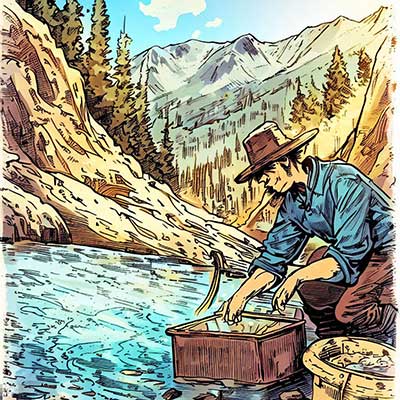
In 1848 when the ship’s captain was replaced due to mental illness in Manila, Manjiro was promoted to Chief Mate, second in command. By going around Africa, Manjiro returned to New Bedford in September 1849 after three years and four months at sea. He earned a hefty $350.
Manjiro then decides to join the California Gold Rush with Whitfield’s blessings. It takes him three months to reach San Francisco in May 1850 on a cargo ship going around South America.
He spends over two months digging for gold in the Sierra Nevada and earns $600, an enormous amount of money, enough for him and his castaway friends to return to Japan. These events are not in the musical.
Return to Japan
After the intermission, the first scene again showed an old map of the Pacific Rim. News reporters Kin, Gin, Ally, and Polly explain that Manjiro returned to Japan and first arrived in Okinawa in January 1851 (age 24) while Japan was still closed to foreign contact (sakoku 鎖国). Okinawa was ruled by the Satsuma Clan in present-day Kagoshima Prefecture.
The musical does not show Manjiro in Hawaii meeting with Denzo and Goemon who both returned with him to Japan. Toraemon had married a local woman and made a living as a carpenter and decided to remain in Honolulu to avoid possible punishment in Japan. Jusuke had died of illness and was buried in Kaneohe.
With the fundraising help of Samuel Damon, Manjiro bought a small whaleboat (which he aptly named “Adventure”) in Hawaii that was loaded onto the ship (Sarah Boyd) that would take them near Okinawa on its way to Shanghai.
When the ship was near Okinawa, they lowered their boat into the water and Manjiro and his two boatmates rowed to Odohama Beach (大度海岸) on the southern tip of the main island of Okinawa in present-day Itoman, Okinawa.
Their initial landing on Okinawa and encounter with the local people is another story in itself and not covered by the musical. That Okinawan beach has been nicknamed “John Mung Beach” and even has a statue of Manjiro.
After their return to Japan, what followed was months of interrogations and meetings with government authorities. First by Satsuma officials in Okinawa, then in Kagoshima. The three returnees were then taken to Nagasaki for questioning by national government officials (shogunate). They were in custody of the authorities for nine months and were not allowed to travel freely.
The musical shows only Manjiro being interrogated by samurai authorities. He explains about America being a democracy where the leader (US president) is elected every four years. There was no class system like in Japan. There was also electricity, the telegraph, and railroads. He urges Japan to open up to the world. But the samurai authorities could not understand what he was talking about.
In Kagoshima (Satsuma), Manjiro finally meets daimyo Shimazu Nariakira who is much more understanding and in favor of reforming Japan. Nariakira treated Manjiro as a VIP and wanted to learn more about the West. It was a friendly meeting.
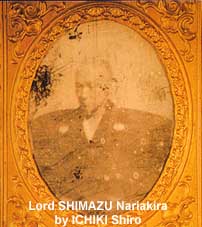
Nariakira was already passionate about Western learning and technologies since childhood when he was fascinated by his grandfather’s large collection of western things like clocks, musical instruments, telescopes, and microscopes. He also had a daguerreotype camera and had his photograph taken in 1857, one of the most famous in Japanese photography history and a National Important Cultural Property.
The Satsuma Clan in Kagoshima was in favor of adopting western technologies, especially for military applications. They eventually helped to overthrow the Tokugawa samurai government in favor of the emperor and paved the way for Japan’s westernization and modernization during the latter 19th century.
After being back in Japan for a year and a half, Manjiro was finally released and was allowed to return to Tosa where he reunited with his mother Shio in early October 1852. He was gone for 11 years and 10 months, and Shio thought he was dead. It was a joyous reunion. Manjiro supposedly brought back a camera to take a picture of her and a sewing machine since she worked as a seamstress. This was not in the musical.
In Tosa, Manjiro was forbidden to leave Tosa or talk about foreign countries to people. He stayed with Tosa artist Kawada Shoryu (河田 小龍) who was ordered by the Tosa daimyo to hear Manjiro’s stories and record and illustrate them. The result is the famous Hyoson Kiryaku (漂巽紀畧) or Summary of Drifting Toward the Southeast book in four volumes. Very valuable record of Manjiro’s life in America complete with illustrations.
Manjiro was appointed as a teacher in Tosa to teach what he knew about Western technologies and marine navigation. Meanwhile, Denzo and Goemon settled in Usa, Kochi Prefecture.
Opening Japan
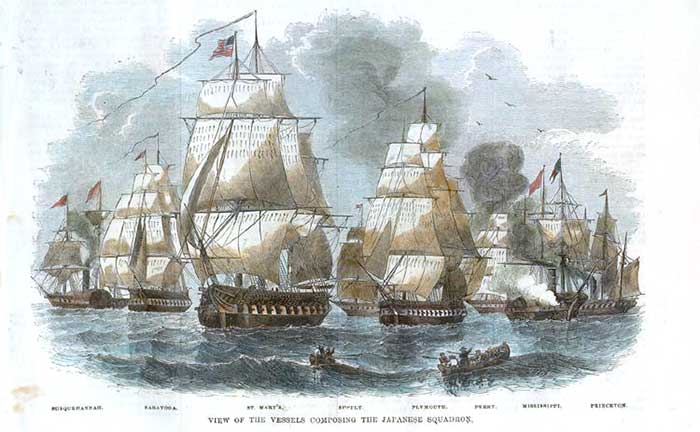
Next major scene was the arrival of Commodore Perry and his Black Ships in 1853 to open up Japan to foreign ships. The stage background had a Black Ship motif, but Commodore Perry does not appear as a character in the musical. No depiction of the treaty negotiations either.
Instead, only Manjiro appears and explains that the Americans wanted three things: 1. The opening of Japanese ports to American whaling ships to replenish provisions. 2. Aid for shipwrecked sailors. 3. Opening trade relations with America.
In 1853, before Perry’s second visit to Japan in 1854, the samurai government summoned Manjiro to Edo. Manjiro was promoted to a hatamoto high-ranking samurai which allowed him to take a surname and carry swords. He chose “Nakahama,” after his home village of Nakanohama.
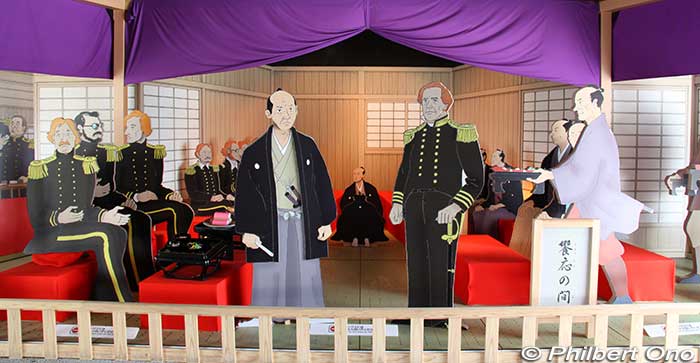
He also starts teaching at the Tosa samurai school Kojukan (教授館) in Tosa where his students included Goto Shojiro (Meiji government politician) and Iwasaki Yataro (founder of Mitsubishi).
Manjiro was not allowed to meet with Perry and his men in person. The samurai authorities feared that he might be a spy or sympathizer for the Americans and end up giving the Americans more favoritism in the Treaty of Kanagawa negotiations.
While working as a translator for the Tokugawa government, Manjiro was involved in shipbuilding and teaching marine navigation, surveying, whaling, etc., all over Japan. He also got married in 1854 at age 27. His wife Tetsu (鉄) was the daughter of kendo master Danno Gennoshin (団野 源之進). They had a son and two daughters. However, Tetsu died of measles in 1862 while still in her 30s. Tetsu does not appear in the musical.
In 1857 at age 30, Manjiro started teaching at Japan’s naval academy in Tsukiji, Tokyo. He taught what he learned in America: English, marine navigation, surveying, etc.
The naval academy was later headed by Katsu Kaishu who got along very well with Manjiro as they both thought the current leadership in the samurai government were incompetent.
Joining the Japanese Embassy to the U.S.
While Manjiro was working as a teacher, Katsu Kaishu requested him to join the Japanese Embassy to the U.S. in 1860 to get the Treaty of Amity and Commerce ratified by the U.S.
Manjiro joined the Japanese Embassy’s entourage as a translator aboard the Kanrin Maru and was finally going to visit the U.S. as a Japanese, a longtime dream for him.
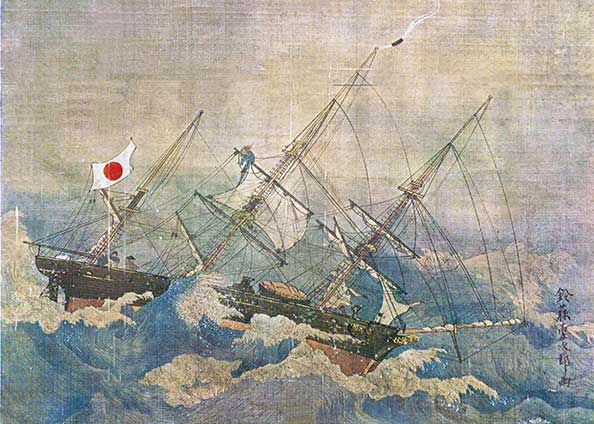
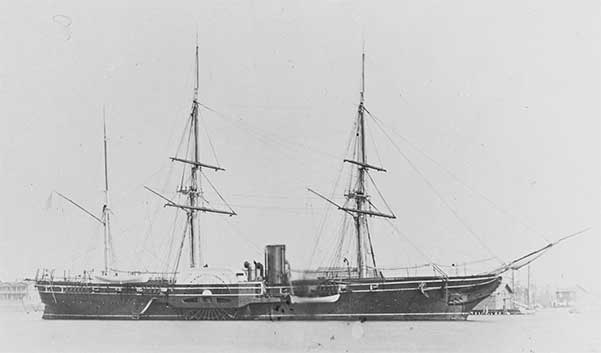
Japanese Embassy officials traveled on the USS Powhatan (the same ship in Commodore Perry’s “Black Ship” fleet), while Manjiro and the rest of the entourage went on the Kanrin Maru, Japan’s first steam warship purchased from the Dutch.
The man in charge of the Japanese Embassy’s trip was Kimura Kaishu (does not appear in the musical), a naval magistrate. He picked the crew for the Kanrin Maru and many of them were from the naval academy headed by Katsu Kaishu. He also picked Manjiro as the translator and Fukuzawa Yukichi as his assistant.
Since he wasn’t too confident with the skills of the Japanese crew sailing across the Pacific, Kimura also brought in a few American crew members as technical advisors including John Brooke, an American naval officer, to help with navigation and communications with the Americans. This was wise since Brooke and Manjiro ended up piloting the ship as Japanese crew members were inexperienced in storms and commander Katsu Kaishu got seasick.
The musical shows Manjiro, Katsu Kaishu, Fukuzawa Yukichi, etc., on the Kanrin Maru to America. The Kanrin Maru departed Uraga (near Yokosuka) on January 19, 1860.
During the voyage, they got low on water, so they ruled that water must only be used for drinking. Whoever breaks the rule is to be shot at once, ruled John Brooke. However, one American crew member was caught using water to wash his underwear.
He draws a gun, but Manjiro convinces him to disarm and get along with the other crew.
Thanks to Manjiro’s navigational skills, they express joy at reaching San Francisco (Mare Island) safely on March 17, 1860 after 37 days across the Pacific. An image of San Francisco in the distance is projected on the stage’s background screen.
The musical then ends with the entire cast coming on stage and singing together in the curtain call. The main theme song is called Open Your Heart (Kokoro wo Hiraite 心を開いて) sung at the end. It encourages the Japanese to open their hearts to America and to the world. They take a few bows amid audience applause until the curtain falls.
The musical had two main messages: 1. Believe in others and understand them. 2. Have the encourage to face adversity.
Manjiro’s famous motto, “Never give up!” was also declared in English in the musical.
The musical’s title refers to Manjiro’s multiple dreams which came true thanks to his positive attitude, adventurism, natural talent, and risk-taking. There are so many amazing stories related to Manjiro, both personal and historic, occurring during one of Japan’s most pivotal times in its history.
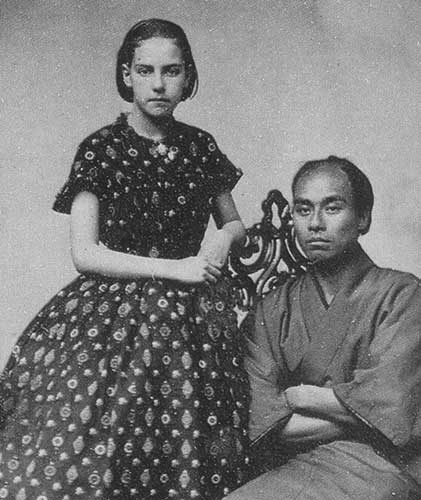
Supplemental
The Kanrin Maru reached San Francisco before the Powhatan which had stopped in Hawaii along the way to replenish provisions depleted during a storm. The Powhatan arrived San Francisco on March 28, 1860, eleven days after the Kanrin Maru.
The entire group from the two ships consisted of 96 Japanese men. The Kanrin Maru stayed in San Francisco for a few weeks for repairs. Fukuzawa Yukichi took advantage of this time by touring the city and mingling with the locals.
He famously had his picture taken with a local girl in a photo studio. She was photo studio operator William Shew‘s 12-year-old daughter Theodora Alice Shew. He also bought a Webster English-Chinese dictionary he used as reference to create an English-Japanese dictionary. (Fukuzawa is on the current Japanese ¥10,000 bill.)
The Kanrin Maru left San Francisco on May 9, 1860, stopped in Hawaii, and arrived in Uraga on June 23, 1860 with Manjiro and Fukuzawa Yukichi aboard.
Meanwhile, the Japanese Embassy crossed Panama by train and changed ships to sail on to Washington, D.C. to meet with President Buchanan who ratified the treaty.
In 1870 after studying military science in Europe, Manjiro managed to visit America again and reunite with Whitfield. Manjiro was mainly an educator during his final years in Japan.
In May 1960, San Francisco’s sister city Osaka erected a monument in San Francisco to mark the arrival of the Kanrin Maru 100 years before.


Performance Schedule
“The Dream of John Manjiro” musical is touring nationwide in Japan from spring 2023 to spring 2024. It started in Tokyo from March 11 to April 2, 2023 at the 500-seat Shiki Theatre JIYU near Hamamatsucho Station. Admission was ¥7,000 with all reserved seating.
It will return to the Tokyo area on April 29 (Sagamihara), July 2 (Shinjuku), and Dec. 26 (Tokorozawa). Tickets go on sale about four months before the performance. The shows often sell out, so they might not have any tickets left at the door. Check here for ticket availability at the door.
The show will travel to Aichi (Nagoya) and Mie Prefectures in May 2023; Tokyo (Shinjuku on July 2), Yamaguchi, and Hiroshima Prefectures in July 2023; Kyushu, Tohoku, Hokkaido, and Shizuoka in Aug. 2023; Chiba and Aichi in Sept. 2023; Hyogo and Kyoto Prefectures in Oct. 2023; Gunma and Saitama in Dec. 2023; Shiga, Wakayama, and Osaka in Jan. 2024; Okinawa in Feb. 2024; and Nagano in March 2024. Schedule in Japanese here. Buy tickets online here.
Program booklet is ¥1,000. It contains most of what you can read on the official website. It has some photos of the cast and staff rehearsing the musical. Nothing in English.
About Shiki Theatre Company
Shiki Theatre Company (劇団四季) was founded in July 1953 by ten Japanese college students led by the late Asari Keita (浅利慶太). His father also worked in the theatre in the 1920s, and his great uncle was the late Kabuki actor Ichikawa Sadanji II. Asari passed away in July 2018.
Shiki Theatre Company has grown into one of Japan’s largest theatrical troupes with 1,300 actors and staff. The troupe has seven dedicated theaters in Japan. It also performs at other venues when necessary. “Shiki” means “Four Seasons.”
They have been performing Japanese adaptations of Broadway musicals including the long-running Cats, Phantom of the Opera, Beauty and the Beast, Mamma Mia!, Lion King, and Frozen. Disney has been in their repertoire since 1995. They perform straight plays and Japanese and foreign musicals.
Every year, they have several shows on nationwide tours putting on 3,000 performances for 3 million theater goers. It was a tough time during the pandemic in 2020 when they had to close their theaters and cancel performances resulting in huge losses and no work for their performers. Thankfully, they are back on stage again.
Ticket Information
They have a ticket page in English. Ticket prices are cheaper for children Grade 6 or younger. Prices include tax.
Web page in English: https://www.shiki.jp/en/ticket_guide/
In Japanese: https://www.shiki.jp/tickets/
Further reading
Official site: https://www.shiki.jp/en/
John Manjiro musical: https://www.shiki.jp/applause/johnman/
John Mung Museum – In his hometown of Tosashimizu, this two-story museum traces the life of John Manjiro. At Cape Ashizuru, a statue of Manjiro gazing at the ocean is nearby. John Manjiro’s reconstructed home in Tosashimizu is also open to the public.
Whitfield-Manjiro Friendship Society – Captain Whitfield’s home in Fairhaven is now a museum. The Society conducts tours of the homes and schools Manjiro attended in Fairhaven. It also holds the Manjiro Festival in Fairhaven in Oct. in odd-numbered years.
John Manjiro-Whitfield Commemorative Center for International Exchange – Holds the Japan-America Grassroots Summit.
The Saga of Manjiro – Summary of Drifiting Toward the Southeast translated by Junji Kitadai.
There have been at least two other Japanese musicals about John Manjiro. One was titled John Manjiro that ran in 2018. Another is titled John My Love running for a year since Dec. 2022.
*Manga images (square) in this blog post were AI generated for illustrative purposes only. They do not reflect actual people, places, things, scenes, or conditions.